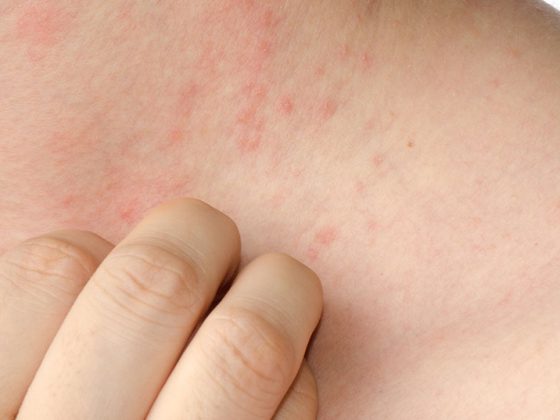Pain and fever in the child put parents in worry and cause uncertainty. It is important to clarify the causes and, if the general condition is poor, to treat it with analgesics and antipyretics.
Focus on finding the cause
Fever is the reason for 70% of all consultations with a pediatrician or family physician and is defined as a rectal temperature above 38°C [1]. This increase in temperature is an important defense mechanism that inhibits the proliferation of bacteria and viruses and makes immune responses more efficient [2]. Infectious diseases are the most common cause of fever. Particularly in the first years of life, children contract self-limiting febrile infections eight to ten times a year, 90 percent of which are viral and 10 percent bacterial.
The highest priority in fever is to find the cause and, if necessary, to treat it causally. In cases of high fever above 39°C, a physical examination and detailed history must be obtained to determine whether a severe invasive bacterial infection is present. The general condition of the child is important in the assessment. If a child is unaffected by fever, a self-limiting viral or causally treatable focal infection can be assumed. However, febrile infants under three months of age should always be examined extensively, as symptoms of illness are often mild.
If the child suffers from fatigue, loss of appetite, headache, pulse and respiratory acceleration, dehydration, limb and muscle pain, and if no cause of the fever is apparent after a detailed examination, further laboratory diagnosis is necessary. In 20 percent of infants, however, no cause of fever can be found. However, this is often not a rare disease but merely an atypical presentation of a common disease [1].
Treat for poor general condition
Fever does not initially require treatment. High fever, however, puts a strain on the circulation and often leads to poor general health, which warrants treatment. The administration of fever-reducing medication should be based exclusively on the child’s condition, because the aim of fever reduction is not to restore normal temperature but to make the child feel better.
Because fever is often accompanied by sore throat, earache, or headache, acetaminophen and ibuprofen have proven effective as treatment options because they reduce fever and relieve pain. The dosage recommendation for acetaminophen should not be exceeded because of its narrow therapeutic range, as overdose can lead to acetaminophen toxicity, a common cause of acute liver failure in children [3].
Unlike acetaminophen, ibuprofen has additional anti-inflammatory effects and is safer in overdose [4-6]. For pain relief, ibuprofen was superior when compared with acetaminophen and codeine [5]. Further studies showed that ibuprofen could reduce fever not only longer but also faster than acetaminophen, achieving fever reduction after only 15 minutes [7, 8]. Both agents were well tolerated and showed a similar safety profile in children three months of age and older [6]. No increased risk of gastrointestinal bleeding, Reye’s syndrome, renal failure, or anaphylactic shock was observed with ibuprofen treatment [6].
Headaches also widespread in children
Pain in children can be triggered by teething, accidents or psychological factors in addition to infections. Headaches in particular are very common in children. Thus, as many as 37-51 percent of seven-year-olds and 57-82 percent of 15-year-olds regularly suffer from headaches that are not infection-related [9]. Migraines can also affect even young children [10]. Among seven to eleven year olds, eleven percent already suffer from it, and by the age of puberty, up to 23 percent do [10]. Again, acetaminophen and ibuprofen are the drugs of choice for acute pain management [9].
Strawberry flavor – popular with children
When children reject medications, it is often because of the bitter taste [11]. In addition, since children have difficulty swallowing tablets, juices are particularly suitable for oral administration. Here, strawberry flavor has been shown to increase acceptance. For example, a juice for a sore throat found acceptance by 94 percent of subjects if it tasted of strawberries, while only 56 percent of children would take the same orange-flavored juice again [12]. In another study, 95 percent of children preferred a strawberry-flavored proton pump inhibitor preparation to a peppermint-flavored one [13]. With NUROFEN® suspensions, in addition to the orange* flavor, an ibuprofen juice with strawberry flavor is now available in Switzerland for the first time, which can also be administered individually and safely by means of a dosing syringe [14].
Conclusion
Antipyretic and analgesic measures are useful in cases of reduced general condition [3]. Although acetaminophen has traditionally been used as the drug of choice in children, study data suggest several advantages of ibuprofen [4-7, 15]. For the acceptance of a drug in children, presentation and taste are crucial [11, 16]. NUROFEN® Junior Forte is the only ibuprofen juice on the Swiss market with the strawberry flavor that is particularly popular with children [12-14].
Interview
 When action is required in the case of pain and fever, and which therapies are suitable, you can read in the interview with the specialist for internal medicine Dr. med. Hans-Ulrich Kull
When action is required in the case of pain and fever, and which therapies are suitable, you can read in the interview with the specialist for internal medicine Dr. med. Hans-Ulrich Kull
Dr. Kull, when should pain in children be treated with medication?
Since the cause of the pain is often not immediately obvious, it is advisable to wait and see if relief from the pain can already be achieved by sedating the child. However, if the pain is very distressing, persistent or recurrent, or becomes more severe, it should be treated with medication. However, it is important that pain is not only relieved symptomatically, but that its causes are always investigated.
At what temperature do you recommend medication for fever?
In general, drug lowering of fever should be considered from 38.5-39°C. But that also depends on the child. Some children have fevers frequently, others very rarely. With children who often have a fever, you tend to be more cautious and wait at first.
When would you give acetaminophen and when would you give ibuprofen?
If an inflammatory cause for the fever is thought likely, ibuprofen is preferable because, unlike acetaminophen, it has an anti-inflammatory effect in addition to its analgesic effect. This would be the case, for example, with mumps or parotitis or inflammatory sore throat. If the cause of the fever is unclear and associated with pain, I would first treat with paracetamol and later administer additional or alternating ibuprofen. However, there are different opinions among physicians regarding the tolerability and effect of ibuprofen and paracetamol, which are certainly largely due to the personal experience of the individual physician. For both drugs, however, it is certainly true that tolerability and effect also depend on the dose.
What is your opinion on the alternating administration of ibuprofen and paracetamol?
I have had good experience with the combination or alternating administration of both active ingredients, as this allows the dose of both preparations to be reduced, which results in fewer side effects. But here, too, opinions differ and some places advise against it. In Germany, for example, the immediate administration of ibuprofen tends to be preferred to alternating or combined therapy with paracetamol.
Taking medication is often uncomfortable for children and can pose major challenges for parents. How important is the taste of the syrup here?
Taste certainly has a big influence. A juice with a bitter or unpleasant taste will be rejected by the child, but it should not be too sweet either. A medium sweet raspberry or strawberry syrup, on the other hand, is always appreciated, but of course there are other flavors. Suppositories are very useful in very young children, because a crying child does not swallow.
RB-M-31282
This article was produced with the financial support of Reckitt Benckiser (Switzerland) AG, Wallisellen.
*NUROFEN® Dolo Junior Orange will be available in pharmacies and drugstores from summer 2021.












